Recent Fire Damage Posts
Expert Fire Restoration Services by Team Shaw of Town & Country
11/8/2024 (Permalink)
 Front desk at Team Shaw HQ
Front desk at Team Shaw HQ
Fire damage is among the most devastating events a property owner can face, leaving behind not just visible destruction but hidden dangers and persistent odors. For those in Town & Country, Team Shaw provides specialized fire restoration services that bring expertise, efficiency, and compassion to each project, ensuring properties are safe and fully restored. Here’s why Team Shaw of Town & Country is your trusted partner in fire restoration.
1. Swift and Strategic Response to Limit Damage
After a fire, time is critical. Smoke residues and soot can settle into surfaces, causing permanent staining and lingering odors. Team Shaw’s rapid response team is available 24/7, arriving promptly to assess and mitigate the damage. Their proactive approach helps prevent further structural damage and keeps restoration costs as low as possible.
2. Comprehensive Smoke and Soot Removal
Smoke and soot can penetrate walls, furniture, fabrics, and HVAC systems, leaving behind more than a visible stain. The microscopic particles from smoke can irritate respiratory systems and create long-term health risks if not addressed properly. Team Shaw uses advanced equipment and cleaning solutions to eliminate smoke particles and residue, restoring indoor air quality and ensuring all surfaces are safe and residue-free.
3. Odor Removal Technology
Odors from fire damage are notoriously challenging to eliminate. They can linger for months if not treated correctly. Team Shaw of Town & Country uses state-of-the-art deodorization techniques, such as hydroxyl generators and ozone treatments, to neutralize smoke odors at a molecular level, ensuring that your property smells fresh and clean once again.
4. Restoring Structural Integrity
Fires can weaken the structure of buildings, leaving behind compromised walls, floors, and roofs. Team Shaw’s fire restoration professionals conduct a thorough assessment of the building's stability, identifying areas that need repair or reinforcement. They bring in structural drying tools, dehumidifiers, and moisture meters to ensure no hidden damage is left unchecked, which helps restore the safety and integrity of your property.
5. Handling Personal Belongings with Care
In addition to structural damage, fires can impact personal belongings, many of which hold sentimental or practical value. Team Shaw takes great care with the contents of your home or business, using specialized cleaning, deodorizing, and restoration methods for items like electronics, documents, furniture, and personal items.
6. Compassionate Support and Guidance Throughout the Process
Recovering from a fire can be an emotional journey. Team Shaw understands this and is dedicated to providing clear communication and compassionate support at every step. Their team will work closely with you to navigate the insurance process, provide updates on the restoration timeline, and ensure all your concerns are addressed.
7. Local Expertise with National Standards
As part of the Town & Country community, Team Shaw has a deep understanding of the needs and challenges specific to the area. They are committed to providing top-tier fire restoration services that meet rigorous industry standards while staying attuned to the needs of their neighbors in Town & Country.
The Path to Recovery
Fire restoration requires a trusted partner who understands the intricacies of damage repair, odor removal, and emotional recovery. Team Shaw of Town & Country combines technical skill with heartfelt service, ensuring your property and peace of mind are restored. Whether it’s a small kitchen fire or a more extensive blaze, Team Shaw is here to help you rebuild and move forward with confidence.
Fight Fire with Know-How: Cleaning Techniques for Different Types of Fire Damage
11/27/2023 (Permalink)
Fire damage may occur in many forms, including different types of fires, and can cause extensive damage to buildings and personal property. The fire restoration process typically involves cleaning, which is a critical step in restoring the property to its pre-fire condition. However, different types of fire damage require different cleaning techniques. In this blog, we will explore the various cleaning techniques for different types of fire damage.
Types of Fire Damage
There are three types of fire damage: dry, wet, and protein. Dry fire damage occurs when fires are fueled by wood, paper, or other organic materials. Wet fire damage occurs when the fire is fueled by synthetic materials or plastics, which produce thick, black smoke. Protein fire damage occurs when food is burned and produces a unique odor.
Dry Fire Damage
Dry fire damage is typically less severe than other types of fire damage. The most effective cleaning technique for dry fire damage is dry sponge cleaning. This technique involves using a sponge or cloth to remove soot and other debris. Using a vacuum cleaner is also recommended to carefully remove the soot residue.
Wet Fire Damage
Wet fire damage produces a lot of soot and ash, which can make cleaning difficult. Wet fire damage requires wet cleaning techniques, such as pressure washing and steam cleaning. The pressure washing technique is highly effective in removing soot and debris from surfaces. Steam cleaning is also efficient as it uses hot steam to break down and remove the ash and soot from affected areas.
Protein Fire Damage
Protein fire damage produces a sticky residue that clings to surfaces, making it difficult to remove. This type of fire damage requires cleaning agents specifically designed to break down the sticky residue. The cleaning technique for protein fire damage involves using a combination of degreasers and specialized detergents. Careful handling is necessary during this process to avoid damaging surfaces.
Restoration Services
In severe cases, hiring professional restoration services is recommended. Restoration companies have the expertise and equipment needed to handle any type of fire damage, including structural repairs, deodorization, and content restoration.
In conclusion, fire damage can cause widespread damage to property and objects. Depending on the type of fire damage, specific cleaning techniques are needed to remove soot and other residues from affected areas. Cleaning techniques such as sponge cleaning, pressure washing, steam cleaning, and specialized cleaning agents can effectively address different types of fire damage. For severe fire damage, professional restoration services are recommended. They provide a comprehensive approach to restoration, ensuring a complete recovery from fire damage. If you need help with cleaning and restoration after a fire, contact a professional restoration company with experience and knowledge in handling different types of fire damage.
Fire Safety 101: Protecting Your Home and Loved Ones from the Threat of Fire
8/14/2023 (Permalink)
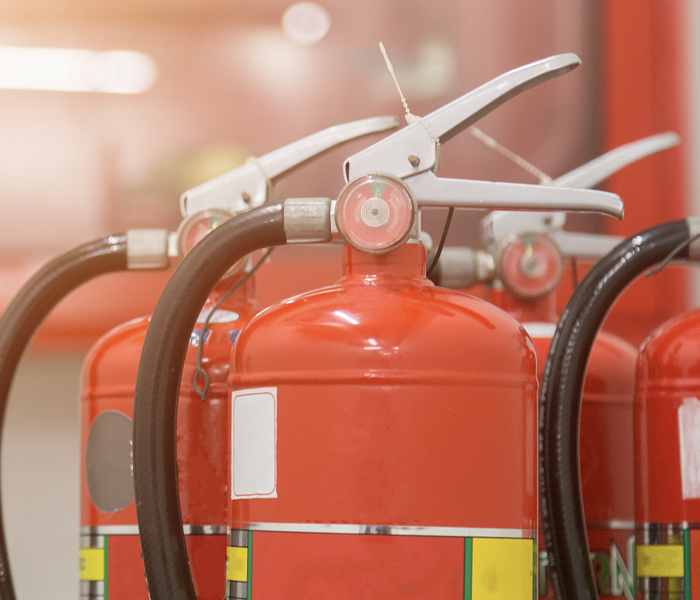 Have a fire extinguisher in your home or business incase of a fire.
Have a fire extinguisher in your home or business incase of a fire.
Keeping your home and loved ones safe from the threat of fire is a top priority. Fires can be devastating, causing property damage, injury, and even loss of life. However, by taking preventive measures and implementing fire safety practices, you can significantly reduce the risk of a fire occurring in your home. In this blog post, we will provide you with essential tips on how to prevent fire in your home and create a fire-safe environment.
Install Smoke Alarms
Smoke alarms are your first line of defense against fires. Install smoke alarms on every level of your home, including inside and outside bedrooms. Regularly test the alarms to ensure they are in good working condition, and replace batteries as needed. Consider upgrading to interconnected smoke alarms that will all sound an alarm if one is triggered.
Have a Fire Escape Plan. Create a fire escape plan for your household and make sure everyone knows what to do in case of a fire. Identify two ways to escape each room, establish a meeting point outside, and practice the plan regularly. Ensure that everyone knows how to crawl low under smoke and how to use a fire extinguisher if necessary.
Maintain Electrical Safety
Faulty wiring and electrical malfunctions can lead to electrical fires. Regularly inspect electrical cords and outlets for damage, and replace or repair any frayed or exposed wires. Avoid overloading outlets and use surge protectors for added safety. If you have older or outdated wiring, consider consulting an electrician for an upgrade.
Exercise Caution in the Kitchen. Cooking-related fires are a leading cause of home fires. Always stay in the kitchen while cooking, and never leave a hot stove unattended. Keep flammable items like curtains, potholders, and paper towels away from heat sources. Install a fire extinguisher rated for cooking fires (Class K) in the kitchen and know how to use it properly.
Practice Candle Safety
Candles can create a cozy atmosphere, but they also pose a fire hazard. Never leave candles unattended, and keep them away from flammable materials and out of reach of children or pets. Consider using flameless LED candles as a safer alternative.
Heating equipment, such as space heaters and furnaces, can lead to fires if not used correctly. Keep at least a three-foot clearance around heaters and other heat sources. Turn off space heaters when leaving the room or going to sleep. Have furnaces and chimneys professionally inspected and cleaned annually.
Properly Store Flammable Materials
Store flammable liquids, such as gasoline, paint thinners, and cleaning solvents, in a well-ventilated area away from heat sources and in approved containers. Keep them out of reach of children and store them according to the manufacturer's instructions.
If you have a fireplace or wood-burning stove, have it regularly inspected and cleaned to prevent the buildup of creosote, which can ignite and cause a chimney fire. Use a sturdy fireplace screen to prevent sparks from flying into the room.
Practice Safe Smoking Habits
If you smoke, do so outside and utilize designated outdoor areas away from flammable materials. Ensure cigarettes are fully extinguished in a sturdy ashtray and never dispose of smoking materials in planters or mulch.
Have fire extinguishers readily available in key areas of your home, such as the kitchen, garage, and near fireplaces. Make sure family members understand how to use the extinguishers and regularly check their expiration dates.
Preventing fire in your home requires a combination of preparedness, awareness, and proactive measures. By following these essential tips and implementing fire safety practices, you can create a fire-safe environment for you and your loved ones. Remember, fire safety is a priority, and investing time and effort in prevention today can save lives and protect your home tomorrow.
From Smoke to Structural: The 6 Types of Fire Damage Every Homeowner Needs to Know About
4/12/2023 (Permalink)
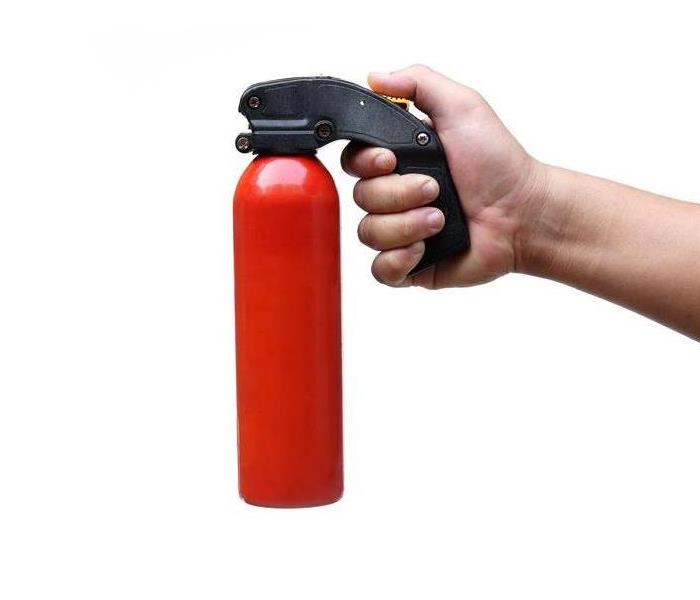 Understanding the different types of fire damage is important to better understand the fire situation.
Understanding the different types of fire damage is important to better understand the fire situation.
Fire damage can be a devastating experience for any homeowner. Understanding the different types of fire damage can help you better assess the situation and know what steps to take to restore your home. In this article, we'll discuss the six types of fire damage homeowners should know about.
Smoke Damage
Smoke damage is the most common type of fire damage. It occurs when smoke particles and soot settle on surfaces such as walls, ceilings, and furniture. Smoke damage can cause discoloration, staining, and a strong odor that can be difficult to remove.
Water Damage
When firefighters extinguish a fire, they use water to put out the flames. This can cause water damage to your home, including warped floors, mold growth, and damaged ceilings and walls. It's important to address water damage immediately to prevent further damage and mold growth.
Structural Damage
Structural damage occurs when the fire damages the structural integrity of your home. This can include weakened support beams, damaged roof trusses, and compromised walls. Structural damage can make your home unsafe to live in and requires immediate attention from a professional.
Heat Damage
Heat damage occurs when the intense heat of the fire causes materials to warp, melt, or even combust. This can include damage to appliances, electronics, and plastics. Heat damage can be difficult to repair and may require replacement of the affected materials.
Chemical Damage
Chemical damage occurs when chemicals used to extinguish the fire damage your home. This can include damage to carpets, flooring, and furniture. It's important to clean up any chemical residue as soon as possible to prevent further damage.
Fire Damage to Personal Belongings
Fire damage can also extend to personal belongings such as clothing, jewelry, and furniture. Smoke and water damage can cause discoloration, staining, and other types of damage. It's important to document any damaged items for insurance purposes and consider hiring a professional restoration service to restore your belongings.
In conclusion, understanding the different types of fire damage can help you better assess the situation and take the necessary steps to restore your home. If you experience fire damage, it's important to contact your insurance company immediately and document any damage for insurance purposes. Additionally, it's crucial to hire a professional restoration service to handle the cleanup and restoration process to ensure your home is safe and habitable. By taking these steps, you can begin the process of restoring your home and moving forward from the devastating effects of fire damage.
The Most Common Fire Damage Questions And Answers
12/9/2022 (Permalink)
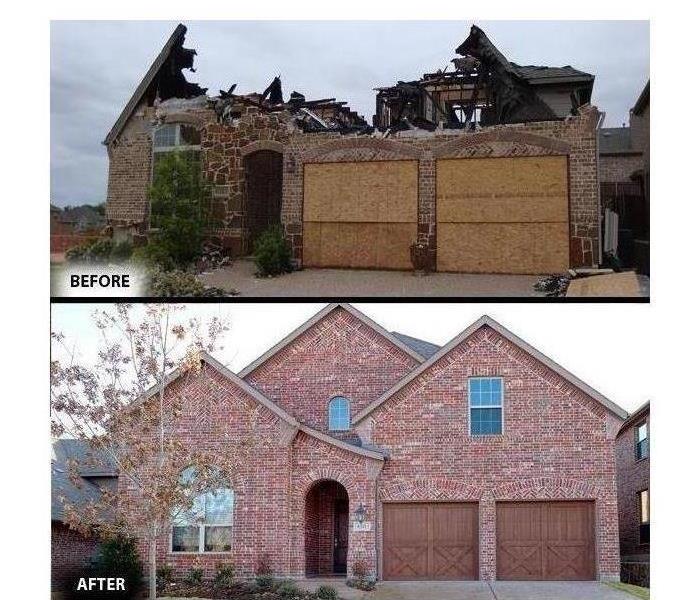 Fire restoration experts in Houston, TX
Fire restoration experts in Houston, TX
When you're dealing with fire damage, one of the most important things to remember is that there are several steps involved in cleaning, repairing, and restoring your home or business. Each step has its own benefits as well as drawbacks, so it's important to weigh out all your options before making any repairs.
How do fires start?
Fires can be caused by many things, including faulty electrical wiring. Fires can also be started by overloaded electrical circuits or a downed power line. A fire can even start when items such as paper, wood and clothing catch on fire.
What are the three classes of a fire?
There are three classes of fires:
- Class A: These are common fires, such as wood and paper. They can be extinguished with water.
- Class B: Examples include flammable liquids like gasoline, diesel fuel or oil. This type of fire requires a dry chemical extinguisher to put out the flames.
- Class C: Electrical fires often involve equipment that generates or uses electricity. When these types of fires occur, it's very important to turn off power at its source before you attempt to fight them by using a properly rated fire extinguisher filled with carbon dioxide gas (CO2).
How does smoke affect my belongings?
Smoke can cause discoloration and damage to your belongings. For example, smoke can stain walls, upholstery, and other surfaces. If the smoke has a strong odor after a fire, it may permeate your clothes and other items in your home.
You’ll need to thoroughly clean all soiled or stained items before you wash them with detergent and water (in most cases). The best way to remove odors is by using an ozone generator machine that produces ozone gas which will oxidize the molecules of the smell producing chemicals into non-odor compounds that are much less pungent than those emitted by the original source material.
What does cleaning and repairing my home from fire damage usually involve?
First, the smoke and soot must be removed from the home. Next, any remaining fire damage will need to be removed from your home. The third step is repairing the damage caused by the fire. Finally, you'll need to clean your home using professional cleaning services.
What if I need restoration services for my business, not just my home?
You’re probably aware that smoke damage can be particularly difficult to clean up, especially if it comes from a major fire. In fact, most fire and smoke restoration companies are trained in everything from cleaning out the ducts in your home to removing smoke odors that have permeated walls and curtains. However, if you need help restoring your business after a disaster or accidental fire, look for a company with extensive experience working with commercial properties.
Consider how much damage has been done during assessing the situation before calling any restoration service. If it appears as though there won’t be any significant structural repairs needed at this point—and it would make more sense to focus on cosmetic issues like replacing drywall or carpeting—consider hiring a contractor instead of an actual restoration company because they will likely be able to provide better estimates for these types of services compared to a professional who specializes in cleanup only (which may also cost less).
There are several things to consider when dealing with fire damage.
First, it's important to know that fire damage can happen to anyone, whether you live in an apartment or a mansion. Fires can be caused by many different things, including space heaters, candles, and faulty electrical wiring. If you have a fire in your home or business, it's important to know what to do so that you can quickly contain the flames and restore your property as soon as possible.
Conclusion
The best thing you can do for yourself and your family is to have a fire escape plan in place. You may never need it, but if you do, you’ll be glad that you planned. If your home or business ever suffers from fire damage, remember these tips: keep track of all receipts so that you can make an insurance claim; get a cleaning crew if possible; and don’t forget about restoration services!
Can Fire-Damaged Contents Be Cleaned?
8/30/2022 (Permalink)
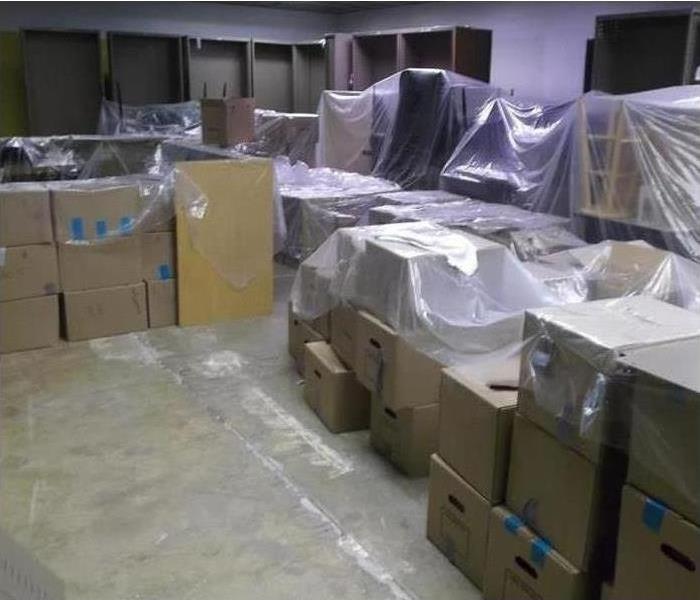 After a fire, there is a lot of stuff that needs to be cleaned.
After a fire, there is a lot of stuff that needs to be cleaned.
Content Cleaning Methods
A fire can destroy many contents, but it may be possible to clean items that are only exposed to smoke, ash, and soot. Damage mitigation professionals provide a variety of content cleaning methods. These methods range from dry-cleaning to foam and wet cleaning. Learn more about the best treatments for different types of items.
Non-Porous Contents
Hard, non-porous items and surfaces can stand up to heavy-duty cleaning processes. Some of the most effective methods include:
- Abrasion or blasting
- Immersion
- Ultrasonic waves
Immersion and ultrasonic waves are often combined for maximum effect. These methods work best on smaller items that can be easily dipped in a bath of cleaning solution and treated with high-pressure waves. Larger items or surfaces may call for wet cleaning.
Porous Contents
Porous items absorb moisture and may not be good candidates for immersion or wet cleaning. The following methods are recommended for these materials:
- Dry-cleaning
- Spraying
- Wiping
Restoration professionals use specialized methods and solutions that may be more effective than consumer-grade treatments. Ask an expert which method is best suited to a particular item.
Delicate Contents
Care must be taken not to damage delicate contents. Books and documents call for different cleaning methods than treatments for textiles or upholstery. The best approaches for cleaning delicate materials may include:
- Chemical sponges
- Foam
- HEPA vacuums
- Immersion
Books and documents may benefit from being wiped with chemical sponges and carefully cleaned with a HEPA vacuum. Upholstery and furniture are ideal candidates for foam cleaning. Ceramics and glass should be able to withstand immersion.
These are all of the major content cleaning methods used by fire damage mitigation professionals. A service may also provide content storage until on-site restoration is complete. Rely on expert recommendations if you are unsure whether dry-cleaning or another method is the best approach for damaged items after a fire at a residence in Bunker Hill Village,TX.
Grill Cleaning and Maintenance Can Prevent a Grease Fire
6/21/2022 (Permalink)
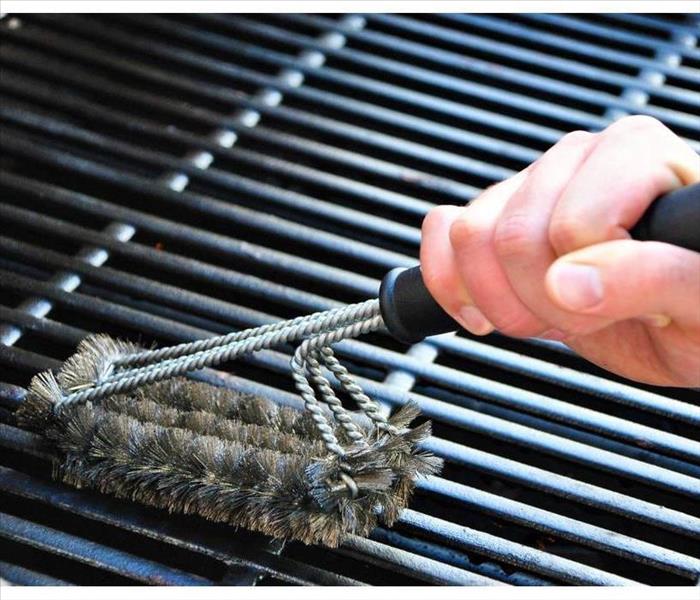 It is important to deep clean your grill.
It is important to deep clean your grill.
Grill Cleaning and Maintenance
Residents of Spring Valley, TX, are looking forward to cooking on a grill again. However, summer fun can end quickly if a grease fire damages your home. Frequent grill cleaning can prevent costly fire damage.
Cleaning Supplies
Have these cleaning supplies available when preparing to clean your charcoal or gas grill for the summer:
- Scouring pad
- Grill brush with scraper
- Dish soap
Grill Maintenance and Deep Grill Cleaning
It is important to deep clean your grill and check for signs of needed maintenance at the beginning of summer. Remove any old ashes from your charcoal grill and scrape the grates with a grill brush and hot soapy water. Rinse with hot water before cooking.
If you have a gas grill, it is important to check for grease under the firebox. Empty the grease collection tray and clean it with hot soapy water. Check the burner hoods for any dirt or grease, making sure the burner ports are clear so flames can pass through.
Repeat the deep cleaning process at the end of summer and store your grill in a dry place or under a weatherproof cover. Additionally, don't forget to remove the ignition battery from your gas grill so it doesn't corrode.
Fire Damage Protection
Make sure you clean your grill thoroughly every time you use it. Scrape any burnt food off the grates before and after cooking and scoop out old ashes from your charcoal grill. If you have a gas grill, empty the grease pan under the firebox and remove any built-up grease, food or ashes from the firebox and burner hoods.
Fires can happen even if you are diligent about grill cleaning. If a fire damages your house, enlist fire restoration specialists from Spring Valley, TX, to coordinate the fire cleanup. Routine cleaning and maintenance will help prevent fire damage, so you can relax and enjoy your favorite summer foods without fear.
How To Secure Your Building After a Fire
5/17/2022 (Permalink)
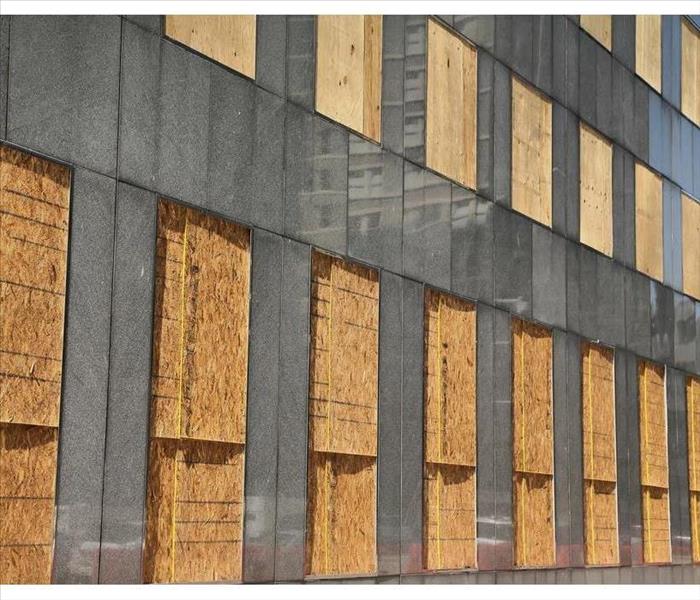 Board-up services and roof tarping are crucial parts of the fire damage restoration process.
Board-up services and roof tarping are crucial parts of the fire damage restoration process.
How to Protect Your Property After a Fire
The amount of damage your building in Spring Valley, TX, sustains after a fire depends on many factors, including how quickly firefighters put out the fire and how many areas of the structure were involved. Even if your building has extensive fire damage, though, you still need to protect what is left from further problems. There are a couple of things that fire restoration experts do to keep your building secure during cleanup.
Roof Tarping During Fire Cleanup
One of the first things technicians are likely to do when they arrive is cover up any vulnerable spots on your roof. Tarping your roof at the beginning of the cleanup process has several benefits:
- Keeps water and debris from further damaging your roof
- Protects the interior of your building
- Helps prevent mold from growing by minimizing damp areas
Another reason to tarp your roof is to ensure that your provider covers the fire damage restoration costs. You can't always prevent a fire. If, however, your building sustains secondary damage due to negligence while it's being repaired, your insurance company may reject your claim, and then you'll be stuck with the bill.
Board-up Services For Damaged Buildings
You'd be surprised how many people try to take advantage of a compromised structure. The restoration team can board up windows, doorways and other spots that the fire left open. This process discourages looting and vandalism. It also keeps animals out and prevents them from nesting in the building.
It's important to let the professionals handle building security. They understand the safety precautions they need to take to arrange tarps and board and secure them in place. The technicians are also less likely to damage the building further than a layperson would be.
Board-up services and roof tarping are crucial parts of the fire damage restoration process. Avoid further issues by making sure your building is protected.
The Key Elements of Fire Damage Restoration
3/25/2022 (Permalink)
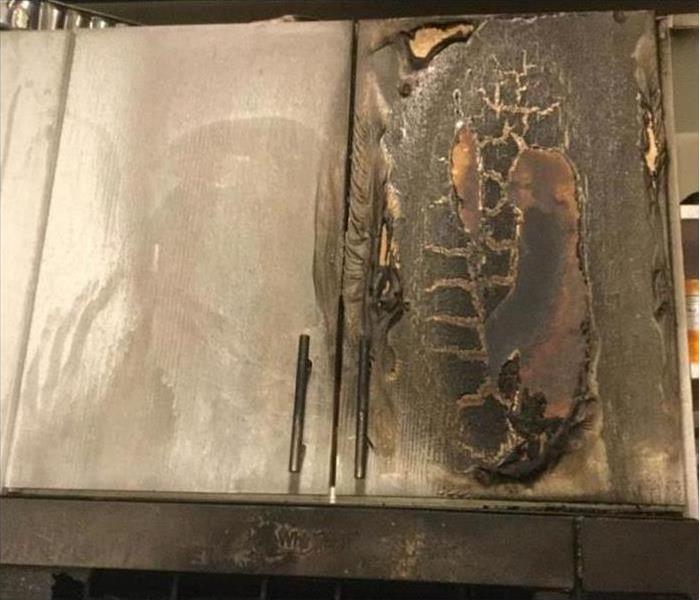 The aftermath of a home fire in Spring Valley, TX.
The aftermath of a home fire in Spring Valley, TX.
The Most Important Factors in Fire Damage Repair
According to the National Fire Protection Association, nearly 30,000 home fires happen every month in the U.S. These fires range from fairly minor to major events that cause extensive damage to a home. Residential fires happen for many reasons, but one commonality in these situations is the need for fire restoration. This is the art and science of restoring a home to its original condition. It is not an easy task and usually requires the services of a professional emergency restoration company. Highly trained technicians work to minimize damage to a home in Spring Valley, TX, reduce costs and expenses and keep everyone as safe as possible.
Proven Methods To Reduce Costs
After a fire, a home is often open to the elements and therefore subject to additional damage from weather. A fire restoration crew will do an immediate board-up or roof tarp service to prevent water from coming into the home. Experienced technicians will also perform some or all of the following actions:
- Water removal and drying
- Mitigation of smoke damage
- Cleaning and repair
- Reconstruction of damaged structures
A team that is conscious of extra costs will practice a restore versus replace mentality. Workers will test materials such as furniture, clothing and carpeting to see if they can be successfully cleaned of soot and odors.
Advanced Training for Improved Safety
In addition to professional damage cleaning, an experienced team will focus on safety. Trained workers know that soot can penetrate all areas of the home including the HVAC system, posing a potential health risk. They also know that the extreme heat of a house fire can make canned goods and other foods unsafe to eat. As part of the fire restoration process, the crew will secure the home against the dangers of falling items and unstable structures. In the aftermath of a home fire, a professional crew works to restore a home safely and efficiently.
What To Know About an Emergency Board Up
2/7/2022 (Permalink)
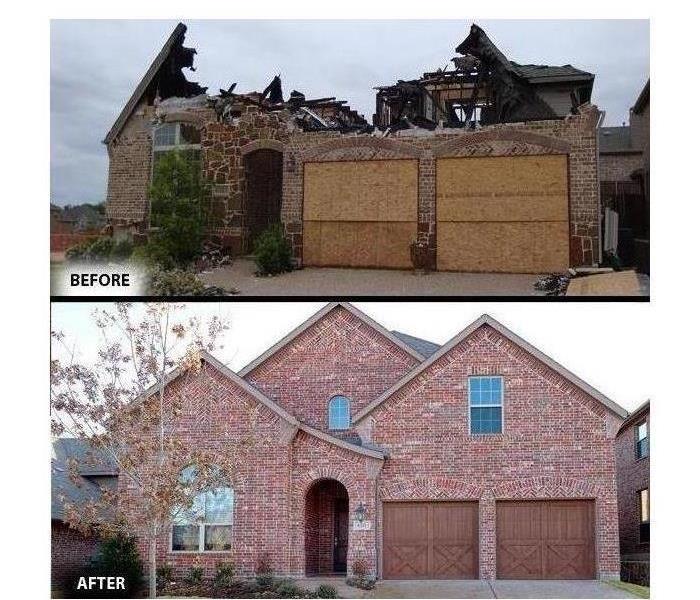 Emergency board-up services in a home in Spring Valley, TX.
Emergency board-up services in a home in Spring Valley, TX.
What You Should Know About Emergency Boarding Up
If your Spring Valley, TX, home has suffered fire damage then you may be looking at the option of doing a board up over the damaged area. There are several reasons you may want to consider this process. Here’s what you may want to know.
How Boarding Up Can Protect Your Home
Having an emergency board up done to protect damaged areas of your home can help protect it from a number of things. Boarding over can
- Prevent inclement weather such as rain or snow from getting inside
- Reduce the possibility of wind damage
- Discourage animals from exploring the damaged area
- Reduce the risk of human trespassers
- Prevent a liability claim from someone who got into the damaged area
- Help maintain insurance eligibility
Insurance Benefits of Boarding Over Damaged Areas
In many cases, your insurance company may require you to board up the damaged area before they will accept your claim. Most policies cover only the initial damages and consider a failure to protect the area before repairs can be made an act of neglect. Boarding over the damage can help show them that you take your responsibilities as a homeowner seriously.
Proper Boarding Up Procedures
Boarding over the damage involves using ply-board or tarps in most cases. It’s important to cover all the damage and secure the edges to prevent weather or animals from getting in. A professional restoration service may be able to do the job for you if you have concerns.
Boarding over the damaged area can not only help protect your home from weather and animals but it may be required by your insurance company when filing a claim. Fortunately, many restoration services offer the option to have their team do the board up for you. When it comes to protecting your home from fire damage, boarding over the area can help save both time and further costly repairs down the road.





 24/7 Emergency Service
24/7 Emergency Service








